Enquanto nós passeamos com um de nossos cães em 12 de Novembro de 2008, nós passamos perto desse assustador dragão selvagem perto da nossa casa.
Ele ficou parado enquanto nós vemos ele. Sera que ele estava esperando a hora certa para nos atacar?
Se você olhar de perto as patas da frente dele estão de cabeça para baixo. talvez ele esteja morto.
Não é todo dia que você vê um monstro horrivel de 35 metros na rua. Talvez ele só comeu uma pequena criança ou um cachorro. Isso é provavelmente porque ele não se move! Nós temos que fikar mais alertas quando passear pela cidade de agora em diante.
Fotos de Urso Branco
Bem Vindo
Powered by IP2Location.com
quarta-feira, 12 de novembro de 2008
Dragão Selvagem e Assustador na rua perto de nossa casa.
Postado por
Urso Branco
às
12:41
0
comentários
![]()
segunda-feira, 27 de outubro de 2008
Dragão Bebê e Fatos sobre os Monstros
Aqui esta um bebê dragão que vive debaixo do pé da ponte sobre o rio na Praça Basilio Ceschin. Many people think of lizards (suborder Sauria of the scaled reptile order, Squamata) as inhabitants of desert regions. But except for the cold arctic and antarctic regions and some isolated islands, lizards are found almost everywhere around the world. Of the almost 3,800 species worldwide, over 110 varieties can be found in the United States. Lizards including iguanas, monitors, geckos, and horned lizards are the most abundant and the most varied and fascinating of the reptile groups. In some regions of the US, people mistake lizards for salamanders. Salamanders and lizards somewhat resemble each other, but are not related. Both are cold-blooded; they cannot maintain body temperatures that are much warmer or cooler than their surroundings. But salamanders are amphibians; they are related to frogs. They have moist skin and have no scales or claws. They usually avoid sunlight, whereas lizards love to stay in the sun. Lizards and snakes are closely related, together making up the reptilian order Squamata. Size: The largest lizard is the Komodo monitor, which can grow to be over 3 meters long (9 or 10 feet) and weigh nearly 300 pounds. The smallest is a certain gecko that is under 70 millimeters total length. Characteristics: Most lizards have dry, scaly skin, four legs, clawed feet, external ear openings, and a long tail. However, glass lizards do not have tails and therefore resemble snakes. They can be carefully identified by their moveable eyelids and/or external ear openings that snakes never possess. Other species, such as horny 'toads,' have short, rounded tails. Also lizards, unlike their snake relatives, usually have a pectoral girdle and sternum. Another observable characteristic of most lizards is a fragile, detachable tail. Many species have a weak fracture plane between their tail vertebra. A slight tug or bump can be all that's necessary and after breaking off, the thrashing tail attracts the would-be predator away from the lizard. In some species and especially in young lizards, brightly colored tails further enhance their probability of being shed rather than losing a life. However, not all lizards lose their tails that readily. Most notable of this group is the collared lizard (Photos above), whose sturdy tail is rarely lost. Lizard tails serve numerous purposes. They aide in balance and locomotion, maintain social status, and are a body area for fat storage. The tail provides a food source during periods of starvation and reproduction. Tail-less lizards also seem to lose social status; for example tail-less males are less likely to find a mate, and tail-less adolescents find it more difficult to acquire a home range. Losing the tail has serious consequences and does put the lizard in a more threatened state of existence. If they live long enough, some lizards can grow back their tail. Food: Lizard diets are highly variable. Most smaller species are insectivores; their diets are dominated by arthropods (insects and spiders). Other species are herbivores. Galapagos Island's marine iguanas feed on algae gathered off the rocks at low tide. Spiny lizards are omnivores, eating both plants and small animals. Some of the larger lizards like the Gila Monster are carnivores; they eat small vertebrates including other lizards. Most lizards detect their food by sight, that is movement of their prey alerts them. Whiptails are believed to use their sense of smell to detect small animals buried in the soil. Most lizards have small teeth in a single row along the edges of both the upper and lower jaws plus patches of teeth on their mouth roof. Food is crushed in their jaws, then swallowed with little chewing. A few species that feed on snails have broad rear teeth for crushing shells. Habitat: Many species of lizards do live in deserts, however other varieties reside in temperate forests, rainforests, prairies, marshes and streams, subterranean burrows, rocky outcrops, and there are even a few gliders in the leafy tops of trees. But the majority of lizards do live on the ground or in trees. Lizards are the easiest reptile to view because they are abundant and because they are most active in warm, daylight summer hours. They usually feed when temperatures raise above sixty-five degrees Fahrenheit. During extreme midday heat, some lizards retreat into burrows and underneath rocks and debris. They may again emerge in cooler afternoon temperature. Other species are more active during midday heat. In southern United States, some species of geckos are entirely nocturnal. Most lizards hibernate through the winter, although a stretch of warm days may bring some out to feed. Locomotion: Lizards move in remarkable ways. Most lizard species are capable of running, climbing, and clinging except for the few burrowing species whose legs are tiny or altogether lacking. A few species of monitors are capable of swimming, and they sometimes navigate from one island to another nearby. A few lizards found in Asia and the East Indies can spread out a fold of skin along the sides of their bodies, forming a sort of sail that they use to glide through the air. These glider lizards are also called 'flying dragons.' Southeastern Five-line Skink Predators: The full range of lizard predators in not known and they vary somewhat from species to species, and are also linked to habitat locations. In general many lizards are eaten by raptors and other predatory birds, carnivorous mammals, snakes, and by other lizards. Defenses: Some lizard species have the ability to easily detach their tails (Photo, below left), thereby giving them a chance to escape from the predator. When threatened, other lizards may bluff by swelling up, hissing, or lashing their tail. Collared lizards, especially the male, will initiate belligerent displays that include a rapid series of pushups. African chameleons are known for the way they can change color, and several other lizards have some of that same ability. And though some species may change color for protection, some become darker or lighter to change the amount of heat they absorb. The Gila monster of southwestern US and the beaded lizard of Mexico are the only poisonous lizards; however, many others should be carefully approached. Not all lizards are harmless fighters. Many species are capable of lacerating human skin with their powerful jaws. Horned lizards, also called 'horned toads,' have sharp spines on their heads and backs plus another strange defense ability. They can squirt a thin stream of blood from their eyes for a distance of three feet. Other Threats: Human activities sometimes threaten the survival of certain lizards. In some countries, people gather their eggs and hunt iguanas and other large lizards for food. Historically, lizards have been killed for their skins in order to make wallets, handbags, and other products. Today, many countries forbid killing lizards for there skins. In many locations, development and construction destroys their habitats.
Ele é 24cm de comprimento, do nariz a cauda.
Note as listras amarelas na cauda dele. Lá tem sete listras mas o amarelo se desmancha quando você chega perto do corpo dele. Lá tem outro bebê que tem listras vermelhas mas eu vi apenas uma vez. talvez seja o mesmo.
Em fatos profundos sobre esses monstros de:
http://eduscapes.com/nature/lizard/index1.htm
Lizards are found around the world and they are a common reptile. 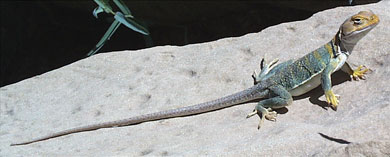
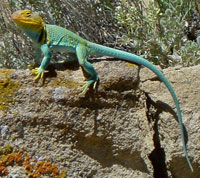
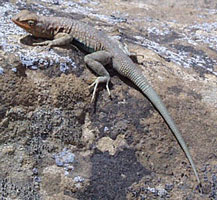
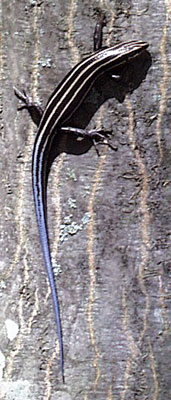
(Eumeces inexpectatus) More often, people see lizards that swiftly scamper over old fences, logs, rocks, tree trunks, and across the ground. Some geckos who spend most of their life in trees have retractable claws. Some have slits in their toes that function like a suction disk, allowing them to cling tightly to vertical and upside down surfaces. Some lizards raise their front bodies and forelegs off the ground and scamper along on their hind legs. Several lizards that live on the ground get along with weak, nearly useless legs or do not have legs at all. Reproduction: Most lizards deposit their eggs in a simple nest. The female skink may coil around her eggs to protect them from intruders. Other lizards do not lay their eggs, but give birth after hatching their eggs inside the body. Still other lizard species reproduce similar to mammals, giving birth to live young. Unlike female mammals, these female lizards do not nurse or care for their young after birth. Some species of North American whiptails and European lacertid lizards have only female individuals; adult females lay unfertilized eggs that hatch only into females. 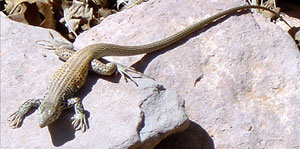

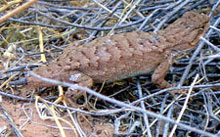
Agora você sabe tudo o que tem para saber sobre dragões!!!
Fotos by Urso Branco e http://eduscapes.com
Postado por
Urso Branco
às
12:38
0
comentários
![]()
terça-feira, 9 de setembro de 2008
A Primavera 2008 está vindo com os Monstros Horrivel
A Primavera de 2008 chega nós denovo somos cercaos por MONSTROS SAQUEANDO!
Esses são os primeiros dessa estação. Este MONSTRO HORRIVEL é tão grande q ele poderia engolir um cachorro grande, talvez até uma pequeno cavalo. Do nariz a cauda ele é quase 35cm de comprimento.
Quando eu vim ao parque a primeira vez eu vi dois deles juntos. Eles moram debaixo da ponte. Essa é a primeira vez que pego dois na mesma foto.
Eu peguei esse aqui sozinho.
Quando eu chegava perto dele ele não se mexia. Ele só olhava com seus olhos apavorantes.
Ele estava lambemdo os labios quando olhava para min eu me assustei e corri o mais rápido que podia.
Fotos de Urso Branco
Postado por
Urso Branco
às
12:36
0
comentários
![]()
terça-feira, 16 de outubro de 2007
Os Monstros Horrivel

Esses horríveis monstros que cospem fogo estão por toda a cidade. As mães não podem deixar seus bebês sozinhos. Até mesmo criancinhas maiores estão em risco.
Todos os cães e gatos de rua desapareceram. Correm rumores que essas criaturas violentas vindas do inferno são responsáveis.
Um canadense idoso que mora no Brasil escapou ileso por pouco. Oh Céus! Nós precisamos que tropas canadenses venham para nos proteger.
Aqui está um gigante de 20 metros rondando pela Praça Basilio Ceschin, devorando tudo no lugar.
Aqui um outro perto do rio, perto da fábrica de água engarrafada. Ninguém mais está a salvo! Nadadores tomem cuidado!
Aqui um outro monstro ao lado dos trilhos do trem. Ele deve ter ao menos 8 metros de comprimento. Não enviarão mais trens através de Águas da Prata por medo que eles ataquem os trens.
Olhe para esta fera selvagem . É assustador não?
Veja esses dentes! Você alguma vez viu alguma coisa tão terrível?
Aqui um outro próximo ao rio. Não há mais peixes lá!
Este tem quase 15 metros de comprimento.
Este está coberto de sangue por ter comido tantos adolescentes indefesos.
Por favor venham nos ajudar a eliminar esta praga de Águas da Prata. Se vocês não puderem vir enviem dinheiro. Nós descobriremos um jeito de fazer um bom uso dele.
Fotos de Urso Branco
Postado por
Urso Branco
às
11:35
0
comentários
![]()



















